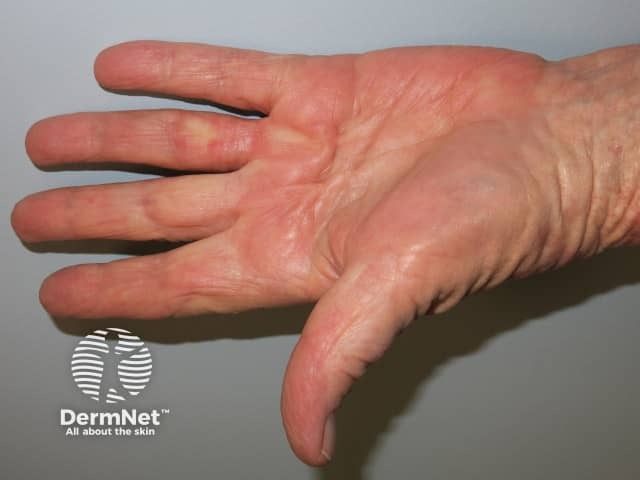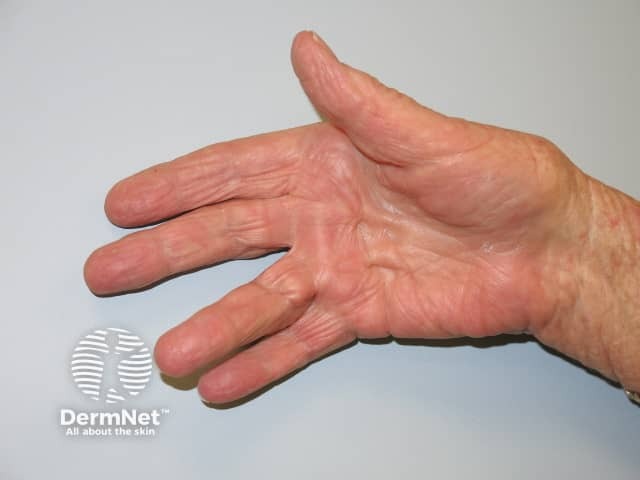Main menu
Common skin conditions

NEWS
Join DermNet PRO
Read more
Quick links
Author: Tae Yeb (Terry) Kim, Medical Student, University of Auckland, Auckland, New Zealand. DermNet Editor in Chief: Adjunct A/Prof Amanda Oakley, Dermatologist, New Zealand. Copy edited by Gus Mitchell/Maria McGivern. April 2019.
Introduction Demographics Causes Clinical features Complications Diagnosis Differential diagnoses Treatment Outcome
Dupuytren contracture, also known as Dupuytren disease, is a progressive fibrosing disorder of the fingers and palm of the hand. It results in the development of nodules and thickened cords in the palmar fascia that may lead to contractures of the fingers [1]. In the later stages, structural changes also involve flexion contractures of the joints.

Dupuytren contracture

Dupuytren contracture

Dupuytren contracture
Dupuytren contracture is a relatively common disorder that occurs with advancing age. About 5–15% of Caucasian men over the age of 50 years are affected [2]. There is a higher incidence of Dupuytren contracture in younger men than in women, but there is no significant difference in incidence between the sexes by the ninth decade of life. It is rare in Asians and African Americans.
The exact cause of Dupuytren contracture is unknown. It is associated with the following factors [3]:
Dupuytren contracture may be inherited as a familial condition or it may occur sporadically. The reason for the dose-dependent association of alcoholism and cigarette smoking with Dupuytren contracture is not understood.
The incidence of Dupuytren contracture is 2–5 times higher in manual labourers than in-office workers, possibly due to repetitive movements and vibration [4]. The association with epilepsy has been reported inconsistently and may be due to anti-epileptic medications.
A Dupuytren contracture is localised to one or both palms and fingers. The disease classically presents in the half of the palm involving the fourth and fifth digits, and it may also affect the third finger.
The first sign is a palmar nodule, which may then progress to a cord [5]. Contractures occur later in the progression of Dupuytren contracture, resulting in difficulty straightening the affected fingers. Additional features may include:
Without treatment, Dupuytren contracture can lead to immobility of the fingers, resulting in the loss of function in the affected hand.
There are no systemic complications associated with Dupuytren contracture.
Dupuytren contracture is diagnosed clinically and no investigations are required.
Dupuytren contracture should be distinguished from the following conditions:
Non-operative treatment for mild Dupuytren contracture may include splinting (external fixation), which may reduce discomfort and lengthen the neurovascular bundle. It is uncertain if splinting, massage or hand exercises stop the progression of contractures [6].
Intralesional steroid injections with lignocaine may reduce tenderness and disease progression, but these are not effective once cords and contractures have developed.
Experimentally, 90% of patients treated with Clostridium histolyticum collagenase injections are reported to have achieved a full extension of the proximal interphalangeal (PIP) joint after a single treatment [7]. The contractures tend to recur more frequently at the PIP joint than at the metacarpophalangeal (MCP) joint.
Surgery is the main treatment for extensive contractures and impaired hand function. Indications for surgery are typically contractures of over 30–40° at the MCP joint and over 20° at the PIP joint. The aim is to restore function to the hands and reverse contractures in the fingers. The surgical procedures for Dupuytren contracture include:
These procedures can be done openly or by using a percutaneous (needle) approach, with or without excision of the overlying skin. Surgery is more effective for contractures involving the MCP joints than for those involving the PIP joints. The recurrence rate after surgery is high, especially in younger patients.
Limited fasciectomy is indicated for patients with loss of function of the affected hand due to progressive contracture. An isolated lesion with a single cord or band responds better to surgery than diffuse forms of the disease and can be operated on more aggressively.
Percutaneous needle fasciotomy is less invasive than fasciectomy and has a fast recovery and low complication rates, but the recurrence rate is up to 65% within 3–4 years [8].
The risks associated with a surgical procedure for Dupuytren contracture include damage to the nerves and flexor tendons and he formation of pseudo-aneurysms (pockets of blood in the bloodstream).
Without treatment, Dupuytren contracture slowly progresses in about one-third of patients [9]. No treatment can completely halt progression or cure the condition.